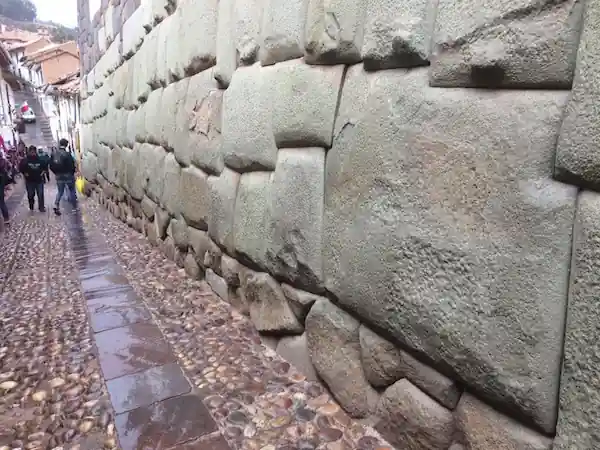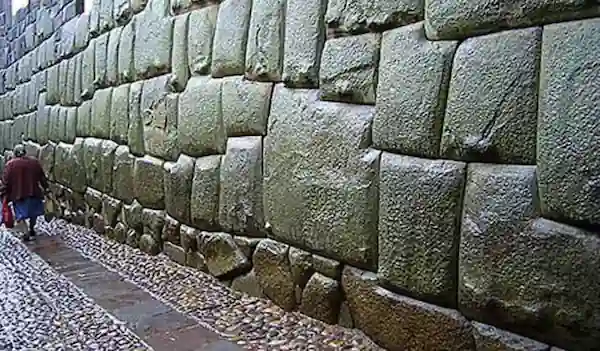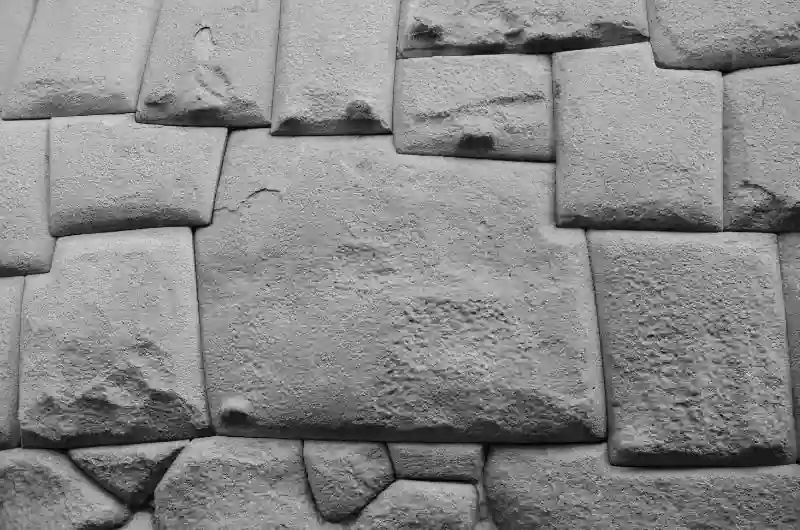Av Retamayoc L-10, San Sebastián 08002
- +51 940 809 144
- Travel Blog
- About Us
- Contact Us
Av Retamayoc L-10, San Sebastián 08002
Chat to a Andean Road Peru
Nestled right in the heart of Cusco, Peru, the Twelve Angled Stone is a stunning showcase of Inca stonework. Distinguished by its intricately carved twelve angles that blend seamlessly with the surrounding stones, this outstanding architectural design showcases the extraordinary artistry and engineering prowess of the Inca empire. But more than just a stone, it holds a valuable cultural history spanning many centuries. A visit to the Twelve Angled Stone offers a unique chance to connect with history and appreciate the creativity behind Inca building techniques.
You might be interested in reading: Mita System: How it shaped the economy of colonial Peru

The Twelve Angled Stone is one of the most famous examples of Inca stonework, located in the historic center of Cusco, Peru. This remarkable stone is named for its precisely carved twelve angles, which allow it to fit flawlessly with the surrounding stones in a wall without using any mortar. This technique, known as ashlar masonry, showcases the Incas’ advanced knowledge of engineering and construction.
The stone forms part of the wall of an ancient Inca palace, which later became integrated into the colonial Archbishop’s Palace. Its perfect fit and unique shape have fascinated historians, architects, and travelers alike, representing the incredible craftsmanship of the Inca civilization. The Twelve Angled Stone not only reflects practical building skills but also holds cultural significance, symbolizing strength, durability, and the ingenuity of a civilization that shaped the history of the Andes.
The Twelve Angled Stone originally formed part of the walls of a royal palace built during the reign of Inca Roca, the sixth ruler of the Inca Empire, who ruled in the 14th century. This palace was located in the heart of Cusco, the ancient capital of the Inca civilization. The exceptional stonework reflected the high status and importance of the structure, symbolizing Inca power and architectural mastery.
After the Spanish conquest in the 16th century, much of the Inca architecture was repurposed or incorporated into colonial buildings. The site of the Inca Roca palace became the foundation for the Archbishop’s Palace, constructed by the Spanish conquerors. The Twelve Angled Stone was carefully preserved and integrated into this new structure, allowing it to survive centuries of change and remain a visible testament to the Inca legacy within the colonial cityscape of Cusco.
The Twelve Angled Stone is located in the historic center of Cusco, along a narrow cobblestone street called Hatun Rumiyoc. This street is famous for showcasing some of the finest examples of Inca stone masonry, with the Twelve-Angled Stone being its most iconic feature.
You’ll find the stone embedded in the wall of the Archbishop’s Palace, near the Plaza de Armas, Cusco’s main square. It’s easy to spot because of its distinctive twelve precise angles and smooth fit with the surrounding stones. Visitors can walk along Hatun Rumiyoc, take photos, and appreciate the craftsmanship up close while exploring the rich history of the city.
The Twelve Angled Stone is a stunning example of the advanced engineering and craftsmanship developed by the Incas. Their stonemasons mastered a technique called ashlar masonry, where stones were cut with such precision that they fit together perfectly without the use of mortar. This technique not only created visually striking walls but also made the structures incredibly durable and resistant to earthquakes.
Each of the twelve angles on this stone carefully shapes to interlock seamlessly with adjacent stones. This creates a stable and long-lasting wall. The builders needed expert knowledge of geometry, patience, and skill. Even small errors could prevent the stones from fitting correctly. This extraordinary precision shows the Incas’ deep understanding of both aesthetics and structural engineering. Thanks to this expertise, many of their constructions have survived centuries of natural wear and seismic activity.
Beyond its architectural brilliance, the Twelve Angled Stone has inspired various myths and legends that add to its mystique and cultural importance. Many locals and visitors believe that the twelve precise angles carry symbolic meanings deeply rooted in Inca cosmology, history, and spirituality. Here are some of the most well known interpretations:
One popular belief holds that the twelve angles represent the twelve months of the Inca lunar calendar. The Incas used this calendar to guide their agricultural and religious activities. It determined the planting and harvesting seasons, which were essential for survival. Therefore, the stone symbolizes the passage of time and the cyclical nature of life. Moreover, it reflects the Incas’ close relationship with nature and their sophisticated understanding of astronomy.
Another legend suggests that the twelve angles represent the twelve original ayllus, or clans, that formed the foundation of the Inca society. These ayllus were essential for organizing labor, land distribution, and social responsibilities. The stone, therefore, stands as a symbol of unity and cooperation among the different groups that built the empire, emphasizing harmony within diversity.
The precise fit and seamless joining of the twelve angles are also interpreted as a representation of harmony and balance values central to Inca philosophy. This balance extended beyond architecture into their worldview, where maintaining equilibrium between humans, nature, and the spiritual world was essential. The stone embodies this ideal, symbolizing stability in both physical and spiritual realms.
Local folklore often attributes mystical protective powers to the Twelve-Angled Stone. It is believed by some that the stone acts as a guardian for the city of Cusco, protecting it from earthquakes, invasions, and other dangers. This belief reinforces the stone’s status not just as a marvel of engineering but also as a spiritual talisman embedded in the heart of the city.
You might be interested in reading: Santa Rosa de Lima: historia, milagros y legado en el Perú

Visiting the Twelve Angled Stone is an essential stop for anyone exploring Cusco’s rich Inca heritage. Capturing this architectural marvel in photographs can enhance your experience and help preserve the memory of this unique site. Here are some practical tips to ensure a smooth and rewarding visit:
To enjoy the stone without the crowds, aim to visit early in the morning between 7:00 AM and 9:00 AM or later in the afternoon around 4:00 PM to 6:00 PM. During these times, the sunlight is softer, casting shadows that accentuate the stone’s twelve distinct angles and textured surface. Midday visits tend to be more crowded and the harsh sunlight can flatten the details in photos.
The Twelve Angled Stone is located on Hatun Rumiyoc Street, a charming narrow street just a few minutes’ walk from Cusco’s Plaza de Armas, the city’s central square. The street is paved with cobblestones and may be uneven, so comfortable walking shoes are recommended. You’ll find plenty of signs and local guides pointing you in the right direction, and the stone itself is impossible to miss due to its unique shape.
Use natural light and avoid using flash to capture the authentic texture and color of the stone. Experiment with different perspectives by taking wide shots to show the stone in context and close ups to highlight the craftsmanship of each angle. Consider visiting during the golden hour, which is shortly after sunrise or before sunset, for warm and flattering light. Be patient and wait for moments when the path is clear to get unobstructed photos. If possible, bring a lens with a good zoom to capture fine details without disturbing other visitors.
The Twelve Angled Stone is part of a historical wall integrated into the Archbishop’s Palace, a protected cultural heritage site. Therefore, it is important to treat the area with respect. For example, avoid touching or leaning on the stones, and do not attempt to climb or write on the walls. Additionally, always follow any posted rules or guidelines. By doing so, you help preserve this remarkable piece of history for future generations.
Since you are already in the historic center, consider exploring other nearby Inca and colonial landmarks. For example, visit the Plaza de Armas, the Cusco Cathedral, and the Qorikancha Temple. Many guided tours include the Twelve Angled Stone as part of their Cusco city tours. These tours provide deeper historical context and enrich your visit.
The Twelve Angled Stone is more than just an extraordinary example of Inca stonework; it is a symbol of Cusco’s rich cultural heritage and a tangible connection to the ancient Inca civilization. This stone represents centuries of history, tradition, and architectural mastery that continue to inspire both residents and visitors alike. Protecting such landmarks is essential to preserving the authenticity and historical significance of Cusco’s historic center.
However, the Twelve Angled Stone faces threats from natural weathering, pollution, and the heavy foot traffic of tourists. Efforts to conserve and protect this iconic monument require cooperation between local authorities, cultural organizations, and the community. By safeguarding this important piece of history, Cusco ensures that future generations can appreciate the legacy of the Incas and maintain the city’s unique identity as a living museum of Andean culture.
You might be interested in reading: 9 lugares turísticos de la sierra peruana

The Twelve Angled Stone represents an amazing representation of Inca craftsmanship, and it serves as a striking representation of the creativity, culture, and history that comprise Cusco and the Inca culture. When a traveler arrives at this famed site they are accessing a moment in ancient Peru's past and witnessing the artistry and vision that is still admired today.
By preserving this stone, we keep its legacy alive, welcoming travelers from all over the globe to witness a genuine masterpiece of human achievement. As long as this stone is preserved, its story is shared, allowing travelers from all over the world to come see a true human masterpiece.

Hola, soy Kevin, un peruano amante de las culturas andinas y orgulloso de mi país. En este blog comparto información útil y confiable para que descubras la historia, la naturaleza y las tradiciones auténticas del Perú.
Leave a comment